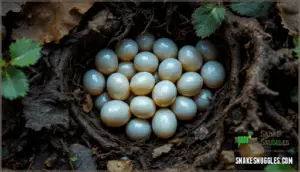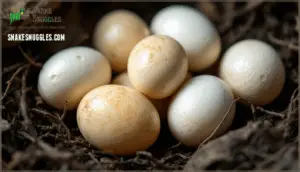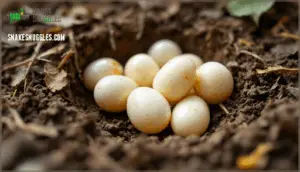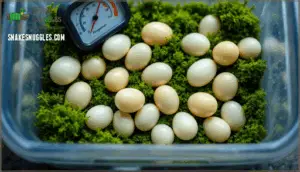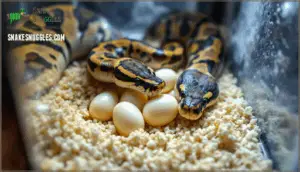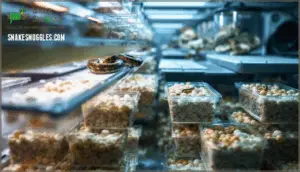This site is supported by our readers. We may earn a commission, at no cost to you, if you purchase through links.
 A reticulated python might produce over 100 eggs in a single clutch, while a ball python usually lays fewer than ten. This dramatic difference shows just how much snake reproduction varies across species. Clutch size depends on factors like the mother’s body size, health, and environmental conditions.
A reticulated python might produce over 100 eggs in a single clutch, while a ball python usually lays fewer than ten. This dramatic difference shows just how much snake reproduction varies across species. Clutch size depends on factors like the mother’s body size, health, and environmental conditions.
Larger snakes generally produce more eggs, but species-specific genetics play a major role too. Some snakes lay eggs once per breeding season, while others skip years entirely.
Understanding these patterns helps breeders maintain healthy populations in captivity and aids conservation efforts for wild snakes. The number of eggs a snake lays reveals important details about its biology and survival strategy.
Table Of Contents
- Key Takeaways
- How Many Eggs Does a Snake Lay?
- Factors Influencing Snake Clutch Size
- Snake Breeding and Egg-Laying Seasons
- Egg-Laying Vs. Live Birth in Snakes
- Snake Egg Characteristics and Identification
- Incubation and Hatching of Snake Eggs
- Ball Python Egg-Laying Habits
- Egg Adhesion and Clutch Structure
- Threats to Snake Eggs and Hatchlings
- Breeding and Incubation in Captivity
- Frequently Asked Questions (FAQs)
- How many eggs does a snake lay per day?
- How many baby snakes does a snake have?
- How many eggs are in a snake?
- How many eggs will a python lay?
- Can environmental factors influence clutch size?
- Do snake eggs require specific humidity levels?
- Are snake eggs edible for humans?
- What health issues affect snake egg development?
- How often do albino snakes lay eggs?
- What do snake eggs smell like?
- Conclusion
Key Takeaways
- Snake clutch sizes vary dramatically by species, ranging from just 2-3 eggs in small coral snakes to over 100 eggs in large reticulated pythons, with this variation driven by the mother’s body size, health, and species-specific reproductive strategies.
- Environmental factors like temperature, humidity, and the mother’s nutritional status directly impact both clutch size and hatching success, making proper conditions critical for egg development during the 40-70 day incubation period.
- Ball pythons show unique maternal care by coiling around their 3-14 egg clutches for 55-60 days, using muscle contractions to generate heat and maintain optimal incubation temperatures—a behavior uncommon among most egg-laying snake species.
- Snake eggs face significant threats from natural predators (with rat snakes causing 70% of nest raids in North America) and human activities like habitat destruction and chemical pollution, making conservation efforts focused on protecting nesting sites essential for population survival.
How Many Eggs Does a Snake Lay?
The number of eggs a snake lays depends largely on the species. Some snakes produce just a handful of eggs, while others can lay over 100 in a single clutch.
Let’s look at the typical ranges you’ll see across different snake species.
Average Egg Count by Species
Why does clutch size vary so much across snake species? It comes down to the mother’s size and the species itself. Larger snakes produce more eggs than smaller ones. Here’s what you can expect:
- Ball pythons lay 4 to 8 eggs per clutch, though rare cases reach 13.
- Burmese pythons produce 40 to 50 eggs on average, with remarkable clutches hitting 96.
- Reticulated pythons average 25 to 80 eggs, but large females sometimes exceed 100.
Smaller species, like grass snakes, lay 10 to 25 eggs, while mud snakes average 30 to 40. These egg count factors reflect each species’ reproductive strategy and the mother’s physical condition. The Sardinian grass snake’s clutch yielded nine healthy hatchlings.
Minimum and Maximum Clutch Sizes
Species Variation in Clutch Size Extremes ranges from two eggs to over 100. Sonoran coral snakes lay just two to three Snake Eggs per clutch, while Texas coral snakes produce up to 12. At the other end, Reticulated pythons average 25 to 80 eggs, with rare cases exceeding 100.
These differences reflect Evolutionary Pressures, Genetic Factors, and Environmental Impact on Snake Reproduction. Of note, some snake species have evolved to give birth to live young, a process known as squamate viviparity evolution.
Body size plays a major role—larger Snake Species produce bigger egg clutches than smaller ones.
Lifetime Egg Production in Snakes
Over her lifetime, a female snake can lay anywhere from a few dozen to several hundred eggs, depending on her species and reproductive years. Snake reproduction biology shows that reproductive energetics play a key role in determining how often a female lays eggs throughout her reptile reproduction cycle.
Ball pythons reach reproductive maturity around three to five years old and can breed for about 25 years. This breeding longevity means one female could produce roughly 125 eggs total. Clutch frequency depends on her fat reserves and access to males.
Factors Influencing Snake Clutch Size
A snake’s clutch size isn’t set in stone. Several biological and environmental factors determine how many eggs a female will produce.
Let’s look at the main influences that shape clutch size across different species.
Species Differences
You’ll find that reptile reproduction biology varies wildly depending on the snake family. Ball pythons usually lay 4 to 10 eggs, while reticulated pythons can produce massive clutches of 25 to 80 eggs.
Colubrids show remarkable family egg variation, with corn snakes laying 10 to 30 eggs but crown snakes managing only 3.
Elapidae egg patterns also differ—king cobras lay 20 to 50 eggs, while coral snakes produce fewer than 10.
Most boas and vipers give live birth rather than laying snake eggs.
Environmental Conditions
While temperature and rainfall directly shape reproductive success, you can’t overlook how environmental factors work together during the incubation period. Climate change threatens snake eggs through extreme weather that disrupts nest conditions, while pollutant exposure from contaminated waterways reduces hatching success.
Your substrate selection and nest site choice matter because they control moisture levels:
- Python eggs need 95-100% humidity at best temperatures to prevent desiccation
- Vermiculite substrate improves hatching success by 35% compared to sand
- Temperature deviations from 26-32°C can decrease hatch rates by 40%
Female snakes adjust egg burial depth and location to maintain stable conditions for their reptile eggs during egg incubation.
Maternal Health and Nutrition
A female snake’s fat reserves and overall body condition determine whether she’ll produce eggs at all—and if she does, how many make it into her clutch. Pre-laying nutrition directly affects egg nutrient composition and clutch size during breeding season. Malnourished females often skip reproduction entirely or produce fewer viable eggs.
Hydration importance can’t be overstated because dehydration impairs egg development. Postpartum recovery depends on maternal body condition before laying, which is why proper animal husbandry practices support reptile reproductive biology and successful reptile breeding through careful maternal behavior monitoring.
Snake Breeding and Egg-Laying Seasons
Snakes don’t follow a one-size-fits-all calendar for breeding and laying eggs. The timing depends on where they live and what species they’re.
Let’s look at how breeding seasons shift across the globe and when you can expect eggs to appear.
Breeding Periods by Hemisphere
Snake breeding doesn’t follow a universal calendar—it shifts dramatically depending on which half of the world you’re in. In the northern hemisphere, breeding season kicks off between March and May. Meanwhile, southern hemisphere snakes respond to their own environmental cues, breeding during September and October.
These latitudinal effects guarantee reptile reproductive biology aligns with ideal conditions. Seasonal variations and climate influence when snakes enter their breeding cycle, making snake behavior and habitat deeply connected to geography throughout the snake life cycle.
Timing of Egg-Laying Events
Once breeding wraps up, you won’t see eggs right away—snakes hold onto them for weeks before finding the perfect spot to lay. In northern regions, egg-laying happens between June and July following the spring breeding season.
This post-ovulation interval allows proper clutch development before deposition time. Seasonal egg-laying patterns ensure that incubation time aligns with warm summer temperatures, giving hatchlings the best chance at survival during their critical early weeks.
Duration of Breeding and Laying
From start to finish, the reproductive cycle takes several months—breeding kicks off in spring, eggs appear by early summer, and hatchlings emerge as fall approaches. Here’s how the timeline unfolds:
- Breeding season length spans March through May in most regions
- Laying interval occurs roughly 4-8 weeks after successful mating
- Clutch completion happens within 24-48 hours
- Incubation time averages 57 days but varies by species
- Seasonal variation shifts reproductive cycles based on geographic location
This extended egg stage guarantees proper snake development stages align with favorable environmental conditions for survival.
Egg-Laying Vs. Live Birth in Snakes
Not all snakes lay eggs. Some species give birth to live young instead. The method a snake uses depends on its species and where it lives.
Oviparous Snake Species
Most egg-laying snakes belong to families like colubrids, pythons, and elapids, and they follow a reproductive strategy where the female deposits her eggs in a protected location and leaves them to develop on their own. Oviparity advantages include reduced maternal energy costs after laying. You’ll find species variations in clutch size range and egg-laying frequency across different oviparous reptile groups.
| Snake Species | Average Clutch Size |
|---|---|
| Ball Python | 3-14 eggs |
| Corn Snake | 12-24 eggs |
| Reticulated Python | 25-80 eggs |
| Coral Snake | 2-12 eggs |
Viviparous and Ovoviviparous Snakes
About 30% of reptile species don’t lay eggs at all. Instead, viviparous snakes nourish embryos through a placenta-like structure, while ovoviviparous species retain eggs internally until they hatch. You’ll find live birth evolution common in boas, sea snakes, and vipers. This climate adaptation protects developing young in cold environments where eggs would freeze.
| Snake Species | Litter Size |
|---|---|
| Green Anaconda | 20-40 young |
| Common Boa | 10-65 young |
| Garter Snake | 10-40+ young |
| Death Adder | Up to 30 young |
Reproductive frequency varies by species. Female adders commonly produce only 1.3 litters over their lifetime, with 70% reproducing just once. Maternal provisioning and body condition strongly influence whether a female will reproduce in a given year.
Geographic and Climate Influences
Where a snake lives shapes whether it lays eggs or gives live birth—cold climates favor viviparous species, while warmer regions support egg-laying. Latitude effects and regional variations create distinct patterns in reptile reproduction. Habitat influence is strongest at high elevations and near the poles, where seasonal changes limit egg incubation success. Climate impacts on species diversity drive these ecology-driven adaptations.
| Region Type | Reproductive Mode |
|---|---|
| Cold/High Latitude | Live Birth Common |
| Temperate Zones | Mixed Strategies |
| Tropical/Warm | Egg-Laying Dominant |
| High Elevation | Live Birth Favored |
Snake Egg Characteristics and Identification
If you’ve ever stumbled across mysterious eggs outdoors, you might wonder if they came from a snake. Snake eggs have distinct features that set them apart from bird eggs and other reptile eggs. Let’s look at the key characteristics that help you identify snake eggs when you encounter them.
Egg Size and Shape
If you’ve ever stumbled across a snake nest, you’ll notice the eggs aren’t perfectly round like a bird’s—they’re stretched out into an oblong shape that gives the developing snake room to grow inside. Snake eggs range from one to five inches depending on the species.
The shell flexibility comes from keratin fibers and collagen layers, making these reptile eggs surprisingly durable. This eggshell structure and function includes egg porosity that allows gas exchange during egg development.
Color and Texture
You’ll notice the shells aren’t hard like a chicken egg—instead, they’ve a soft, leathery feel that’s surprisingly flexible to the touch. Most snake eggs appear white, off-white, or beige in color. This color variation provides natural egg camouflage in dark, sheltered nesting sites.
The leathery texture and shell porosity work together as key reptile egg characteristics. This eggshell structure and function aids proper gas exchange during reptile egglaying and development.
How to Identify Snake Eggs
When you stumble upon eggs in your yard or garden, knowing what sets snake eggs apart can save you from a confusing guessing game. Look for these five key Snake Egg Identification Techniques:
- Egg size: between 1 and 5 inches long, with pythons at the larger end and colubrids smaller
- Shell texture: leathery and flexible, not hard like bird eggs
- Clutch arrangement: eggs stick together in clusters rather than sitting separately
- Color: white, off-white, or beige with no patterns—infertile eggs appear yellowish
- Reptile comparison: elongated shape distinguishes them from round turtle eggs and harder alligator shells
These Reptile Egg Characteristics and Eggshell Structure details help you confirm you’re looking at snake eggs during Egg Incubation and Hatching season.
Incubation and Hatching of Snake Eggs
Once your snake lays her eggs, the waiting game begins. The incubation period depends on several factors that determine when those eggs will hatch.
Let’s look at what influences the timeline and conditions needed for successful hatching.
Average Incubation Periods
Once laid, snake eggs don’t hatch overnight—they need time for embryo development to complete. The average incubation period across species is roughly 57 days, though you’ll see species variation ranging from 40 to 70 days depending on genetics and conditions. Ball pythons usually need 55 to 65 days, while corn snakes require 58 to 62 days.
Temperature influence is critical: warmer conditions speed hatching timing, while cooler settings extend duration factors. Incubation success depends on maintaining proper heat and humidity throughout egg incubation and hatching for healthy reptile biology outcomes.
Role of Temperature and Humidity
Temperature and humidity work like a pair of invisible hands, guiding every step of embryo development inside the egg. Your snake eggs need incubation temperature around 86°F and high humidity levels to prevent egg desiccation.
These climate impact factors directly affect hatching success. Too dry and reptile eggs lose moisture. Too cool and reptile reproduction slows.
Proper reptile egg care balances both conditions for healthy outcomes.
Environmental Effects on Hatching
Beyond the thermostat and humidity gauge, factors like nest location, soil composition, and seasonal weather patterns all shape whether your snake eggs will successfully hatch. Climate change can shift temperature variation during embryo development. Habitat impact from pollution effects threatens humidity levels in natural nests. Even small changes in these conditions affect hatching success.
Your understanding of these environmental influences helps protect reptiles and their egg-laying cycles.
Ball Python Egg-Laying Habits
Ball pythons are one of the most popular pet snakes, and their egg-laying habits are well-documented among reptile keepers. If you’re breeding ball pythons or just curious about their reproduction, you’ll want to know what to expect regarding clutch size, maternal behavior, and incubation needs.
Let’s look at the specific details that make ball python breeding unique.
Typical Clutch Size
Ball pythons lay between 3 and 14 eggs per clutch, with most females producing around 5 eggs on average. Clutch size variation depends on the female’s age and body condition. Younger snakes often produce smaller clutches, while mature females with good fat reserves may lay more eggs. Factors like access to males and overall health also affect how many snake eggs a female produces during each breeding cycle.
What affects ball python clutch size:
- Body weight matters – Heavier females generally produce larger clutches because they have better energy reserves for reptile reproduction.
- Age plays a role – Young ball pythons laying their first clutch usually produce fewer eggs than experienced breeders.
- Nutrition counts – Well-fed snakes with adequate fat stores can invest more energy into egg-laying.
- Breeding frequency – Females that breed annually may show clutch size anomalies compared to those breeding every other year.
- Individual variation – Some snake species show natural differences in clutch size even under identical conditions.
Brooding and Maternal Care
Unlike most snakes that abandon their clutches immediately after laying, female ball pythons exhibit unique brooding behavior. They wrap their muscular bodies around their eggs and remain coiled in place for the entire incubation period.
This behavior provides essential maternal thermoregulation through muscle contractions that generate heat. The post-laying behavior includes nest site selection in secure locations and egg attendance lasting 55 to 60 days.
During the brooding duration, the female protects her snake eggs from predators while maintaining proper humidity for reptile reproduction.
Incubation Details for Ball Pythons
When you incubate ball python eggs, you need to achieve that ideal temperature of 86° Fahrenheit with high humidity for the full 55 to 60 days. Temperature sensitivity matters because even small drops can slow development or cause incubation problems.
You’ll want to use egg candling regularly to check embryo progress and guarantee hatching success.
Proper humidity control prevents desiccation while supporting healthy hatchling care once your ball pythons emerge.
Egg Adhesion and Clutch Structure
When you look at a freshly laid snake clutch, you’ll notice something unusual—the eggs stick together like they’ve been glued. This adhesion isn’t accidental.
It has important biological purposes and requires careful treatment if you’re breeding snakes in captivity.
Why Snake Eggs Stick Together
Snake eggs emerge from the mother coated in a sticky mucus, which acts as a natural glue to hold the clutch together. This adhesion is crucial for maintaining clutch integrity during incubation. The eggshell structure contains proteins that strengthen the bond between eggs, further ensuring the clutch remains united.
Keeping the clutch together offers several advantages, including hatching synchronization and enhanced embryo development. This reproductive strategy holds evolutionary significance because grouped eggs retain moisture better and remain protected in their nesting site.
Impact on Egg Survival
This clustering behavior directly affects how well the eggs survive until hatching. Grouped snake eggs reduce desiccation risk by creating a humid microenvironment that prevents water loss through the eggshell structure.
The clutch location matters because predator impact decreases when eggs stay together in hidden spots. However, tight clustering can increase fungal growth if conditions become too moist.
Despite this risk, the benefits for embryo development and reptile reproduction outweigh the drawbacks, supporting genetic diversity through successful hatching.
Handling Clutches in Captivity
Captive breeders face unique challenges because separating adhered eggs risks damaging the delicate shells, so understanding proper care techniques is key to maintaining healthy clutches. You’ll want to transfer the entire clutch together into your incubation setup without pulling eggs apart. Ball python breeding requires careful humidity control throughout the process to prevent desiccation while supporting genetic diversity in your hatchlings.
- Monitor temperature and humidity daily using reliable gauges for best reptile husbandry techniques
- Practice egg candling weekly to check embryo development without disturbing the clutch structure
- Maintain stable conditions specific to your species, as ball pythons need different care than other snakes
- Keep detailed records of your incubation setup to improve future reptile care and hatchling care outcomes
Threats to Snake Eggs and Hatchlings
Snake eggs and hatchlings face serious dangers in the wild. Predators hunt for eggs as easy meals, while human activity destroys nesting sites.
Here’s what threatens these vulnerable stages of a snake’s life.
Natural Predators
You face tough odds when your snake lays eggs in the wild. Predators from multiple animal groups actively hunt for these vulnerable clutches. Snakes themselves are major threats—over 120 species across seven families prey on eggs. Rat snakes cause roughly 70% of bird nest raids in North America, but they’ll target reptile eggs too. Mammals like raccoons and opossums dig up buried clutches. Birds such as crows and ravens peck through leathery shells.
| Predator Type | Primary Examples | Geographic Hotspots |
|---|---|---|
| Egg-eating snakes | Rat snakes, cat snakes | North America (37%), Africa (24%) |
| Mammals | Raccoons, opossums, skunks | Widespread across continents |
| Birds | Crows, ravens, jays | Low elevations below 500 meters |
Predation frequency varies by location. Snake behavior and evolutionary adaptations help some species survive, but nest predation remains a significant threat to hatching success and wildlife conservation efforts across reptiles globally.
Human Impact and Habitat Loss
Human activity threatens snake reproduction at every stage. Habitat fragmentation from urbanization and agriculture shrinks nesting sites, forcing females into smaller areas where predation rates soar. Chemical contaminants like PCBs and pesticides transfer from mother to egg, reducing hatching success. Microclimate alterations from deforestation strip away the leaf litter and shade that stabilize incubation temperatures. These population impacts compound over time, with recruitment dropping in disturbed landscapes. Wildlife conservation efforts now focus on protecting remaining habitats, as snake habitat and distribution studies reveal local extinctions when degradation crosses critical thresholds.
- Wetland drainage eliminates incubation sites for aquatic species
- Road construction exposes nests to direct destruction and extreme temperatures
- Invasive predators like rats thrive in human-modified landscapes
- Pollutants cause developmental abnormalities in developing embryos
- Fragmented habitats reduce gene flow between isolated populations
Conservation Measures
Protected areas offer the strongest defense for vulnerable eggs and hatchlings. Fencing around nesting sites nearly eliminated predation on sea turtle nests by kukri snakes on Orchid Island by 2001. Predator exclusion trials have boosted reptile egg hatching success by 38% in targeted areas.
Community programs like Save The Snakes now operate in over six countries, training locals in secure practices while funding habitat preservation.
Population monitoring through capture-mark-recapture studies tracks survival rates, with adult protection proving most critical for long-term stability. Research funding drives new conservation strategies.
Breeding and Incubation in Captivity
Breeding snakes in captivity requires careful attention to temperature, humidity, and egg treatment. Success depends on understanding species-specific needs and creating stable incubation conditions.
Here’s what you need to know to improve hatching success.
Best Practices for Snake Breeders
Successful breeding starts with understanding your snake’s natural biology and creating conditions that mirror what they’d experience in the wild. You’ll need to maintain proper temperature gradients and humidity levels throughout the breeding season.
Keep detailed records of clutch sizes, hatching rates, and genetic lineages to support healthy genetic diversity. Breeding snakes requires breeder responsibility, including avoiding hybridization risks that can compromise species integrity.
Monitor your female closely during brooding to confirm she’s maintaining egg health without becoming overly stressed.
Artificial Incubation Techniques
Removing eggs from the female and placing them in a controlled incubator gives you precise control over temperature and humidity throughout development.
Here’s what you’ll need to focus on:
- Set your incubator between 82-88°F depending on your snake species
- Maintain humidity levels around 80-90% to prevent egg desiccation
- Use candling techniques to monitor embryo development without disturbing the clutch
- Check eggs daily for signs of mold, collapse, or abnormal discoloration
These controlled conditions greatly improve hatching success rates compared to natural incubation.
Challenges in Captive Breeding
Even experienced breeders hit roadblocks—from sluggish females who refuse to mate to eggs that mysteriously collapse mid-incubation. Genetic diversity becomes limited in captive populations, increasing disease susceptibility in hatchlings.
Incubation failures often stem from subtle humidity shifts, while hatchling mortality spikes without proper brooding conditions.
Ethical considerations around animal care best practices and reptile reproduction demand constant attention to clutch health and overall snake egg viability.
Frequently Asked Questions (FAQs)
How many eggs does a snake lay per day?
Snakes don’t lay eggs daily. Reproductive physiology works differently in reptiles. Females develop an entire clutch internally before laying all eggs at once during a single event, usually within hours.
How many baby snakes does a snake have?
Like flipping a coin, the number of baby snakes varies wildly. Clutch sizes range from just two or three offspring in smaller reptiles like Sonoran coral snakes to over 100 hatchlings in large reticulated pythons, depending on species and maternal health.
How many eggs are in a snake?
You’ll find the number depends on the species. Internal egg development produces anywhere from two eggs in coral snakes to over one hundred in large pythons.
Clutch size limits relate to the mother’s body size and health, affecting reptile reproduction cycles.
How many eggs will a python lay?
Pythons produce clutches ranging from just a few eggs to over 100, depending on the species.
Ball pythons usually lay 3-14 eggs per clutch, averaging around Reticulated pythons are far more prolific, averaging 25-80 eggs.
Can environmental factors influence clutch size?
Food availability and habitat quality absolutely shape clutch size in snakes. When prey is scarce or pollution effects degrade the environment, females produce fewer eggs. Healthier snakes in better habitats usually lay larger clutches.
Seasonal variation and climate change also impact reptile reproduction.
Do snake eggs require specific humidity levels?
Yes, high humidity is important during incubation. Snake eggs need moisture to prevent desiccation because their porous eggshell structure allows gas exchange for embryo development.
Species variation exists, but most require 80-100% humidity for successful hatching.
Are snake eggs edible for humans?
While technically edible, snake eggs aren’t recommended for human consumption. They offer minimal nutritional value and pose safety concerns due to potential bacteria and parasites.
Cultural consumption exists in some regions, but preparation methods vary. Reptile egg-laying produces eggs best left for hatching.
What health issues affect snake egg development?
Nutritional deficiencies in mother snakes can cause eggshell abnormalities and weak embryo development.
Fungal infections threaten eggs in humid environments.
Desiccation risks increase when humidity drops too low.
Genetic defects may prevent proper hatching in some reptile reproduction cases.
How often do albino snakes lay eggs?
Albino coloration is like wearing a bright costume in nature—it doesn’t change the calendar. Albino snakes lay eggs at the same frequency as normally pigmented individuals of their species.
Genetic influence on coloring doesn’t affect reptile reproduction cycles or clutch size in captive albino laying situations.
What do snake eggs smell like?
Healthy snake eggs don’t have much smell. Fresh eggs are nearly odorless. You might notice a musky or earthy scent near them.
If eggs smell foul or rotten, they’re decomposing or infertile.
Conclusion
Like tuning a telegraph to get the message just right, understanding how many eggs a snake lays requires attention to species, size, and environment. Reticulated pythons can produce over a hundred eggs per clutch, while ball pythons rarely exceed ten.
These numbers aren’t random—they reflect each species’ survival strategy and ecological niche. Whether you’re breeding snakes in captivity or supporting conservation efforts, knowing these patterns helps you provide proper care and protect vulnerable populations for future generations.
- https://dirtyclassroom.com/snake-reproduction-mallory-schmackpfeffer/
- https://a-z-animals.com/articles/how-much-does-a-clutch-of-snake-eggs-weigh/
- https://pmc.ncbi.nlm.nih.gov/articles/PMC9219438/
- http://www.stevenpoe.net/uploads/3/7/3/4/37343605/4494.pdf
- https://www.newscientist.com/article/2367395-invasive-burmese-python-in-florida-lays-a-record-96-eggs-in-one-go/

